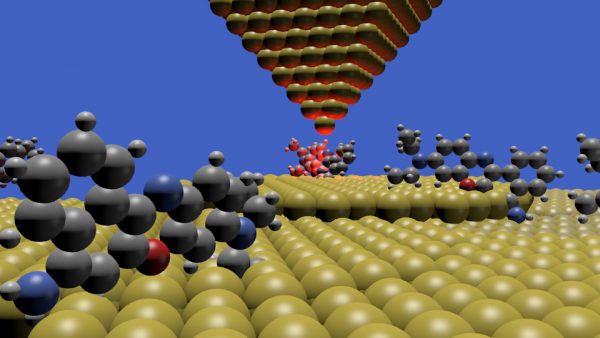THESE NU SCIENTISTS WANT TO HELP YOU UNDERSTAND THEIR WORK, AND THE VALUE OF OBSCURE SCIENCE.
By David Thill
Medill Reports
There’s a language barrier between Mike Mattei and most of the rest of the world. Or maybe it’s more of a dialect barrier.
Mattei, a fifth-year Ph.D. candidate in Northwestern University’s Department of Chemistry, works on a research team studying metal surfaces at the level of nanometers – a billionth of a meter – searching for the ideal spot on the surface for chemical reactions to happen.
He and the other members of Northwestern Professor Richard Van Duyne’s lab conduct this work on a level impossible to visualize without a specialized microscope. And its precise applications aren’t yet known, so you probably won’t be reading about it in the news in the near future.
So when it comes to explaining this work – whether to policymakers, generally interested (or disinterested) members of the public, or even other scientists – the task can be difficult. They’re speaking English, but it’s often hard to understand for those not immersed in the science.
SPOT’s mission is to “bridge the gap between the scientific community and the broader community.”
But Mattei and some of his peers want to help people understand. They believe that now, when public trust in science seems tenuous at best, it’s important to engage people outside the science realm – and hopefully pique their interest – to demonstrate the value of this research.
That’s where SPOT comes in.
SPOT, which stands for Science Policy and Outreach Taskforce, is a new Northwestern student organization of mostly doctoral students and postdocs, also open to faculty and undergraduates. According to Mattei, who serves as the group’s treasurer, SPOT’s mission is to “bridge the gap between the scientific community and the broader community.”
So far, SPOT’s work has included policy advocacy – a heated issue, especially when it comes to topics like climate change – such as helping coordinate other Northwestern organizations’ involvement in the March for Science last April; and community outreach, like visiting senior centers to talk science.
Overall, Mattei views SPOT as a way to strengthen the general public’s trust in the scientific community, and to help them understand complicated science and its relevance to their daily lives.
SKIMMING THE SURFACE
If one wants a challenge explaining complex, seemingly abstract research to lay people, Mattei’s own field offers the perfect opportunity.
Van Duyne’s lab, where Mattei works, has 18 people, 14 microscopes and too many lasers to count. At any given moment, Mattei has several projects going on at once. That way, if there’s a problem – maybe a laser malfunctions and has to be shipped to Scotland for repairs, as was the case one day in November – he always has another task to work on.
To understand the work he and his lab mates do, it helps to have a basic understanding of surfaces, and, by extension, surface chemistry, which is their specialty.
If you think of gold, silver, platinum or any smooth surface, it’s not actually that smooth when you zoom in to look at the individual atoms of which it’s composed. It’s bumpy, because the atoms are arranged imperfectly. Think of falling snow: It doesn’t all just end up nicely packed and flat. It has bumps and ridges and smooth patches.
Now think of walking up your street after a snowfall: It’s much easier to trek through if the walkway is shoveled. Metal surfaces are sort of like that, except instead of our footfalls it’s atoms and molecules that interact with the surface.
Those chemical reactions happen more easily at some parts of the surface – the shoveled parts, figuratively speaking – than others – the unshoveled parts.
And what’s a good way to find the shoveled part of a surface you can’t see? Enter the lasers, which Mattei and his team use to examine surfaces through a technique called tip-enhanced Raman spectroscopy.
C.V. Raman was a physicist from India who died in 1970. He discovered the process now known as Raman spectroscopy. With Raman’s discovery, scientists can direct laser light at a sample of molecules and use the pattern it makes when it bounces back – a “chemical fingerprint” – to identify the molecules.
In Mattei’s work, the Raman spectroscopy is “tip-enhanced.” That’s because Mattei and his lab mates use a tiny gold or silver tip attached to an atomic force microscope. They focus the laser light onto the tip, which enhances the laser’s effects by acting like an antenna, zeroing the light in on a specific spot on the surface. Some of those spots are better for chemical reactions than other spots: shoveled versus unshoveled.

BREAKING BARRIERS
Tip-enhanced Raman spectroscopy – or TERS – is relatively new. Mattei and his colleagues in 2015 and 2016 published papers demonstrating that the method can be used to study electrochemical reactions – reactions that happen on metal surfaces and are electrically driven.
Now they’re on to the next thing: trying to use TERS to examine electrochemical reactions at different spots on the surface – looking for those shoveled spots. It’s like they built the tool, and now they’re trying to see what it’s really capable of.
(Actually, it’s more like they helped build the tool, since other labs are also working to perfect TERS.)
And it’s hard to tell what TERS will be used for as it’s perfected. One possibility, says Mattei, is that it’s used to study surfaces in hydrogen fuel cells, the power source for environmentally friendly hydrogen cars. If you build the fuel cells using only the really good spots on the surface, the chemical reactions will work better, allowing the fuel cell – and the car – to run more efficiently.
Mattei and the other members of the TERS team can’t predict yet how it will impact everyday life. So getting people interested – whether they’re scientists or senators or citizens – can be difficult.
But scientific discoveries that show up in the news – discoveries in outer space, exciting medical findings, science fiction-like technological innovations – couldn’t happen without the fundamentals. Researchers like Mattei believe that explaining such discoveries – even the complicated ones – to the public will help bridge the gap between scientists and their skeptics.
“There’s this image of us being locked away in our ivory towers,” Mattei says. He adds that if you look at popular media, it’s easy to see a recurring theme: that of the eccentric and secretive scientist, whose work often leads to some kind of deadly disaster like a Frankenstein’s monster, a catastrophic disease outbreak or an ill-fated dinosaur park.
But as more scientists seek to communicate their work to the public effectively, through organizations like SPOT and in academic programs devoted to science communication, Mattei and his peers hope to break down the barriers between science and the wider world.


